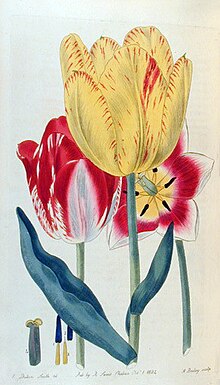
Robert Sweet (1783–20 January 1835) was an English botanist, horticulturist and ornithologist.[1][2]
Born at Cockington near Torquay, Devonshire, England in 1783, Sweet worked as a gardener from the age of sixteen, and became foreman or partner in a series of nurseries. He was associated with nurseries at Stockwell, Fulham and Chelsea. In 1812 he joined Colvills, the famous Chelsea nursery, and was elected a fellow of the Linnean Society. By 1818 he was publishing horticultural and botanical works.
He published a number of illustrated works on plants cultivated in British gardens and hothouses. The plates were mainly drawn by Edwin Dalton Smith (1800–1883), a botanical artist, who was attached to the Royal Botanic Gardens, Kew. His works include Hortus Suburbanus Londinensis (1818), Geraniaceae (five volumes) (1820–30), Cistineae, Sweet's Hortus Britannicus (1826–27), Flora Australasica (1827–28) and British Botany (with H. Weddell) (1831). He died at Chelsea, London in January 1835.
He was charged with receiving a batch of plants allegedly stolen from the Royal Botanic Gardens at Kew. It was suggested that this was an attempt to frame him by an official at Kew whom Sweet had criticised. He was acquitted after a well-publicised trial.
Robert Sweet received high praise from his contemporaries at his trial and was described as possibly the first practical botanist.
- ^ Woodward, Bernard Barham (1898). . In Lee, Sidney (ed.). Dictionary of National Biography. Vol. 55. London: Smith, Elder & Co. p. 197.
- ^ Dawson-Brown, Penelope (January 1997). "Robert Sweet FLS, 1783-1835". The Linnean. 12 (4): 29–34.